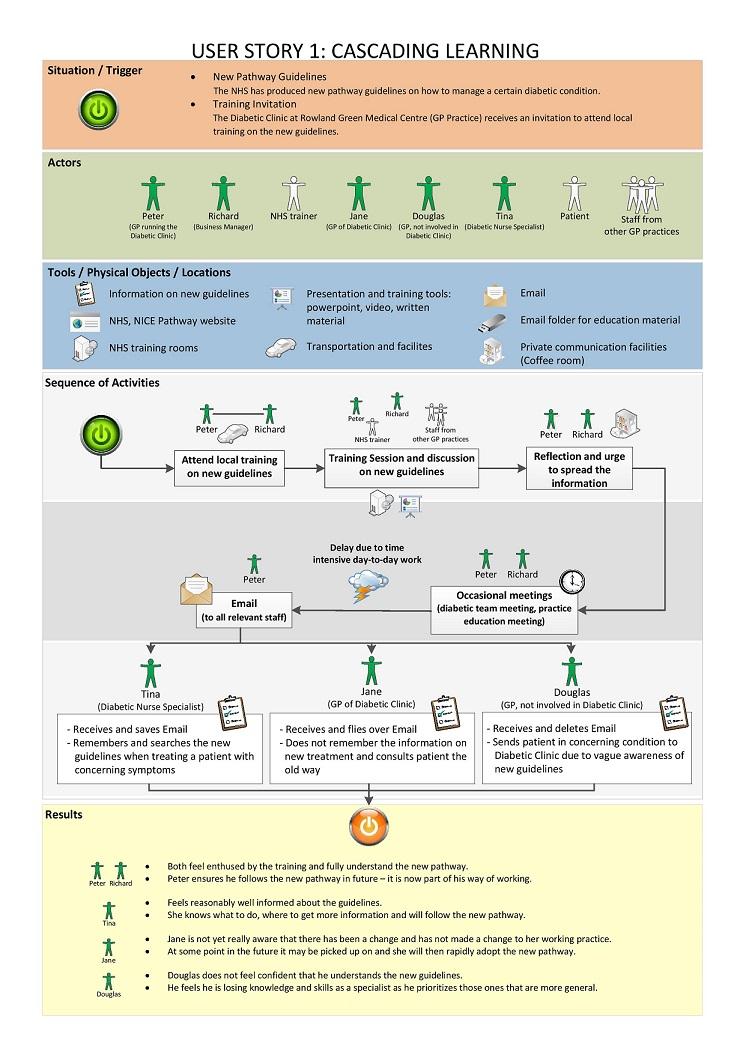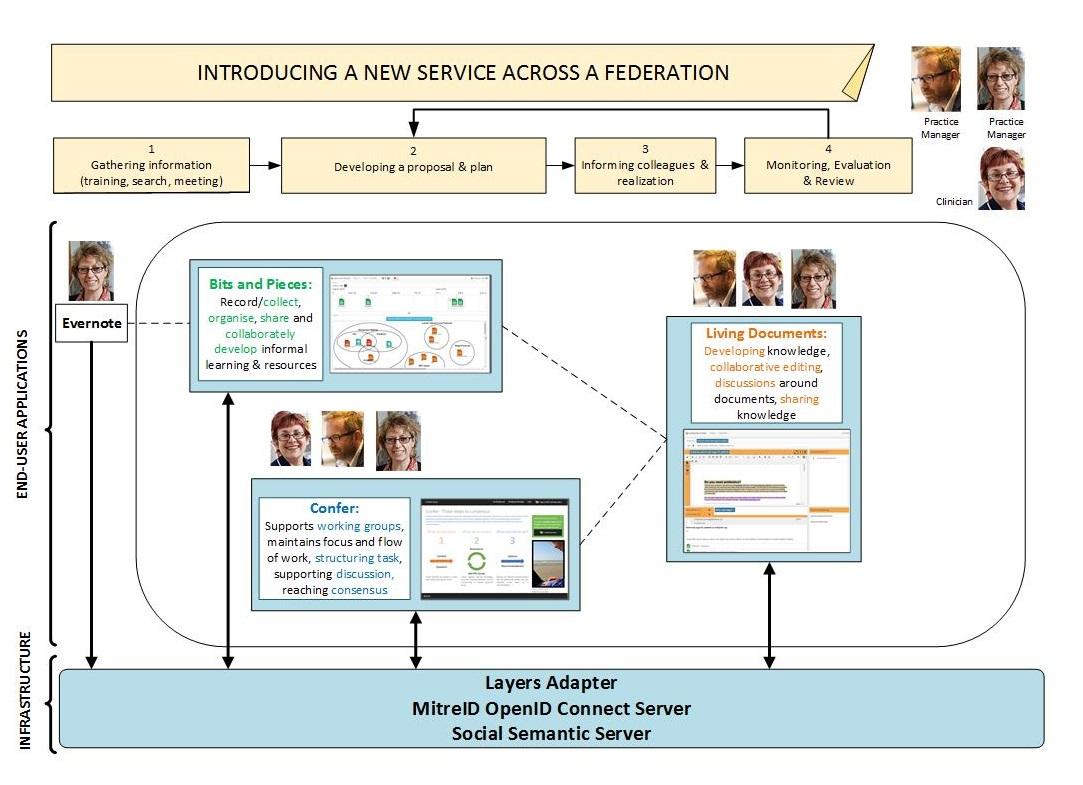Healthcare Teamwork in and between General Practices
Main impacts
- Healthcare professionals managed to engage wider groups in their knowledge building
- They moved from a cooperative to a collaborative mode of working
- Staff was enabled to explore problems more thoroughly and systematically
The situation before Layers
Highlights
Multi-professional teamwork is not only essential to delivering good patient care, but it is also a place where there is a great opportunity for informal learning in and between General Practices. However these opportunities are not always realised. Together with two teams within General Practices and a team working across a Federation of General Practices, we identified a number of challenges to their work:
-
Difficulty in finding time for meetings, given the busy diaries of healthcare professionals
-
Activities on team projects getting stalled in between meetings
-
A tendency for “collaborative” work to end up being mainly undertaken by one person with others just making comments on close to complete drafts
-
Managers or team leaders finding it difficult or time consuming to get an overview of the current activity and progress on a piece of teamwork
Description
GP practices in the UK are independent businesses, which a patient visits to see their family doctor or nurse and receive routine or regular medical care, or the initial diagnosis of more complex conditions. General Practices are usually owned by a group of partner GPs (General Practitioner doctors) and employ GPs, Nurses, Healthcare Assistants, Administrative staff and a Practice Manager. Multiprofessional working is an essential part of their work, as teams work together to deliver patient care, manage and improve the services.
The National Health Service (NHS) is now encouraging General Practices to form Federations, to work together more closely to gain economies of scale, allow practices to offer more services, avoid duplication of effort and share and work collaboratively. The structure and form of these Federations is not mandated, and some are forming as legal entities, some under a multi-practice partnership and others working at varying levels of cooperation and collaboration and in varying sizes of group. They can involve staff working across organisations, protocols and working practices being shared between organisations, and clinics or specialist services being shared between organisations. Federations are relatively new and most are at the stage of defining their form, purpose and scope, and establishing their groups. However, more than half of all UK General Practices are now signed up to some form of larger entity.
Some of the common issues associated with teamwork within General Practices are exposed within the user stories and animation shown below.

Figure 1: User story: Cascading learning
A related user story told in video
Animation showing some examples of multi-professional teams in General Practice
The cascading learning user story was identified by all of our partner General Practices as capturing the most important teamwork challenges and missed learning opportunities issues for them. Similar issues were highlighted by the Practice Managers network (who work across a Federation of General Practices) when we started working with them.
What Layers did
Highlights
Learning Layers took a participative approach throughout the 4 year project, working closely with healthcare professionals to:
-
Identify the pain points in their working/learning practice
-
Co-design tools to support their work and informal learning
-
Field-test these tools with them from an early stage
-
Identify those groups/teams whose work would most benefit from the tools and engage them in the pilots
-
Provide face-to-face and online training and support on using the Learning Layers tools
Description
Empirical studies. In years 1 and 2 of the Learning Layers project we undertook a series of empirical studies in General Practices. These studies focused on exploring how informal learning took place in the workplace and identifying where technology could provide better support. These studies were run in parallel with and fed into the co-design work.
Co-design, capacity building & field-testing. Healthcare professionals from General Practice were involved in the co-design & early field-testing of the Learning Layers tools during years 1 to 3 of the project. During this period, they contributed ideas and feedback into the ongoing development of the tools (Bits & Pieces, Confer & Living Documents), received training on the use of the tools and took part in field-testing of early prototypes. Two teams within the General Practices were involved in this work. One of the teams (GP Practice A) worked with us to co-design and field-test Living Documents and the other team (GP Practice B) co-designed and field-tested Bits & Pieces along with Living Documents.
Participatory identification of pilot groups and use cases. In year 3 of the project the key healthcare professionals who had been involved in the co-design work were invited to a meeting (Learning Layers Mixing & Matching Meeting) at which all of the Learning tools developed within healthcare were presented both by the Learning Layers healthcare lead, but also by the healthcare professionals who had been involved in their co-design. This meeting gave everyone the chance to see all of the tools and to discuss and consider which tools or combination of tools would best fit the needs of the teams or networks in which they were involved. In discussion with the Learning Layers healthcare team, the healthcare professionals themselves identified the groups who would take part in the pilots and which toolsets they would use.

Figure 2: The three Learning Layers tools and a use case discussed at the Mixing & Matching Meeting
More information about each tool can be found at Bits & Pieces, Discussion Tool, Confer, and LivingDocuments.
Tools Pilot. The Practice Managers network who work across a General Practice federation joined the Learning Layers pilot and used the Learning Layers tools for real work tasks over a period of approximately 4 months. The toolset they used (Confer and Living Documents) were introduced to the teams at a 3 hour kick-off workshop (of which about 1.5 hours was training and hands-on use of the tools, the rest was research admin and the evaluation focus group). The team chose a particular problem to explore using the tools during the pilot period. Support (online videos, email support list) and regular contact (weekly hints/tips email to all and regular accompanying conversations with key members of the team) were provided to the teams. An interim workshop (approx 1 hour) was run with each team half-way through the pilot period. At this workshop Learning Layers staff supported the team in using the tools to take their work forward in the meeting itself (e.g. further developing ideas inside Confer) and also collected feedback from the team on their current use of the Learning Layers tools. A final workshop was held during which the participants described their actual use of the tools and the impact it had had.
The video providing an overview of the B&P and Living Documents toolset. All B&P FAQ videos can be found at http://bnp.learning-layers.eu/help/
The situation after Layers
Highlights
A number of positive outcomes and changed practices were observed across the field-testing and pilots:
-
A team working on the development and writing of a joint protocol found that they were able to reduce the number of face-to-face meetings required, since work could be done asynchronously within the tools.
-
The Practice Managers network commented on how they had found the use of the tools helpful in meetings - structuring and recording their discussions and helping them to move the work forward.
-
Through extended and supported use of the tools, a team was able to move their work from following a mainly cooperative model to a more fully collaborative approach (editing and contributing to each other’s work, rather than just commenting)
-
Managers reported that the tools gave them a quick and easy overview of the team’s work, providing them with reassurance that the work was underway
Description
One team used Living Documents to develop a new protocol. An administrator led this work, but others (including a GP and Admin Reception Staff) were able to contribute asynchronously and provide questions and comments as the document developed. The team fed back that they all felt involved in the development. This has also reduced the need for face-to-face meetings, since the team felt able to undertake the work and discussions asynchronously within Living Documents.
Once I saw your comments, and I was able to reply; I found that really useful and helpful
Admin Manager, Living Documents Field-tests Year 3
Doing that for me, was a quick way of dealing with it, rather than us four trying to get some time to look at it all together
Admin Reception, Living Documents Field-tests Year 3
Was quick to do, rather than saying can I meet with you on Wednesday Derek, and you saying well it’s my day off, and Lydia saying I’ve got a meeting at 11…
Admin Reception, Living Documents Field-tests Year 3
Something like this [meeting/discussion] is not going to take 15 minutes (…) so beneficial from that point of view.
GP, Living Documents Field-tests Year 3
implication was that a meeting would use up more time.
The Practice Managers Network used the tools (Confer and Living Documents) to help them to explore a potential new project (setting up a locum service across the Federation). They found the use of the tools in the face-to-face interim workshop to be a useful way of recording the discussion and moving the work forward. As a result of their discussions the team realised that their initial plans (of a service using spare staff capacity across the Federation) was not possible and so this led to the work moving in a different direction. The benefits of using the tools within a meeting was also reported by pilot groups described in the Impact Case C-06.
So, yes it did help with that, it captured that snapshot of that meeting so I think maybe that is some way we could use it a bit more in the future, sort of capture brainstorming.
Pilot A Final workshop
It did consolidate our thinking into realising the project wasn’t going to work <…> channelled our thinking whilst using the tool in a workshop, I think possibly did make that happen more quickly
Pilot A Final workshop
The team, involved in the co-design of Bits & Pieces, had initially used the tools (B&P and Living Documents) in a cooperative manner - splitting up tasks and working on these subtasks individually. Their engagement with each other’s work was limited to commenting. However, following a structured session with the project team, in which they were prompted to collaborate more fully and edit each other’s work (the episodes and circles in Bits & Pieces), they reported quickly seeing the benefits of this richer collaboration. The team are now looking to include more collaborative activities in their general teamwork.
It was the thought of … all the bits were fine … but the thought of if you re-organised all the circles (…) Once you’ve done it once, I wasn’t bothered … just the first time
Business Manager, Pilot D, Final Workshop
It’s good like you start off something, somebody contributes to it, and it’s grown into something very substantial. And you never expected it to reach that point
Admin/Office Manager, Pilot D, Final Workshop
The same team also used the tools (Bits & Pieces and Living Documents) to prepare for a regulatory inspection visit. The GP who had overall management responsibility for that preparation commented on how the tools had allowed him to have a clear overview of the work progress and this also helped him to identify where further help or support could be needed. This not only acted as a reassurance, but also meant that he did not need to send so many emails or set-up meetings with staff to check on progress.
it’s more of kind of a quick glance at what’s happening <…> for me it’s an awareness
Lead GP, Year3 Autumn Field-test
Yeah, and also it stops me having to go and ask Dorothy (Practice Manager) or whoever, “have we go this or is this happening, what’s happening?”, I can, it’s, you can potentially see, as long as you can see what’s, it’s on Bits and Pieces then at least you can say okay, fine.
Lead GP, Year3 Autumn Field-test
Yeah, I might not know the detail, I don’t probably need to know the detail until the final policy comes otherwise I’m going to be inundated, but it’s there and something’s happening and I can sleep.
Lead GP, Year3 Autumn Field-test
Impact that Layers created
Changed learning practices
Our detailed evaluation and analysis of the pilots and field-tests identified 3 changed practices in the teams involved in this impact case. These were how they engaged wider groups in their knowledge building, how they used the tools within face-to-face meetings to capture the discussion and ideas development and how they used the structuring within Confer (progressive inquiry model) to help them to explore the problem space more thoroughly and systematically.
Extended trust building and personal networks
The team that moved from a cooperative to a more collaborative form of teamwork demonstrated firstly fear and apprehension about allowing others to edit their work, but ultimately respect for their collaborators contributions. The actual act of collaboration and being able to see the positive benefits of it appear to have helped them develop greater trust.
Initial fears
I think, probably because, it sounds a bit silly but in Bits and Pieces, I think on the actual Venn diagram and things like that, the person who has created it, it’s very much their baby and you don’t want to interfere.
Participant in Year3 Autumn Field-test
Yeah, I prefer to do my episode, produce my document and then ask people for input, I don’t particularly like other people amending
Participant in Year3 Autumn Field-test
When you start it, when you are the starter of it, and the initiator of it, you do feel like you own it, and you don’t want anybody to touch it
Finance Manager, Pilot D, Final Workshop
Appreciating benefits
I could understand why she’d done it, and it was good that she had done it, as it increased the information content and made the information more clear
Finance Manager, Pilot D, Final Workshop
But it’s funny actually, once you’ve done it once then I wasn’t bothered. <…> It was just the first time with the initial one, oh okay, you might switch all the structure round and that might… But then once I’d done it I was fine.
Participant, Pilot D, Final Workshop
You got different viewpoints that Hazel came up with, things that I wouldn’t have thought of and yeah, it was good to share because there were issues that made you really think about, oh yeah, I never thought of that.
Participant, Pilot D, Final Workshop
Developing greater trust
Yeah, I think it was just the initial thing of passing it over and then I’ve been fine with it and I wouldn’t have been bothered if you’d changed stuff on mine and I wasn’t bothered about changing yours!
Participant, Pilot D, Final Workshop
Links to other sections
- Learning scenarios
- Research methodologies
- Tools
Further Reading
Evaluation
Report of Summative Evaluation in the Healthcare Pilots, [1]
Pilot training and support material links
Links to materials used at kick-off workshops (presentation, support material)
Links to support material (videos, example nudge email)
Links to materials used at interim workshop (guidelines)
Background to the context
Contributors
Graham Attwell, Ed Bellamy (PINBELL), John Bibby, Martin Bachl, Paul Carder, John Cook, Sebastian Dennerlein, Rose Dewey, Raymond Elferink, Manfred Geiger, Paul Hamill (PINBELL), Micky Kerr, Elisabeth Lex, Tobias Ley, Ronald Maier, Markus Manhart, Patricia Santos, Christina Sargianni, Pjotr Savitski (TLU), Andreas Schmidt, Stefan Thalmann, Dieter Theiler, Vladimir Tomberg, Tamsin Treasure-Jones, Lena Waizenegger, David Zaki (HSKA)
References
- R. Dewey, M. Geiger, M. Kerr, R. Maier, M. Manhart, P. Santos Rodriguez, C. Sarigianni, and T. Treasure-Jones, “Report of Summative Evaluation in the Healthcare Pilots,” pp. under review, 2016 [Online]. Available at: Link
